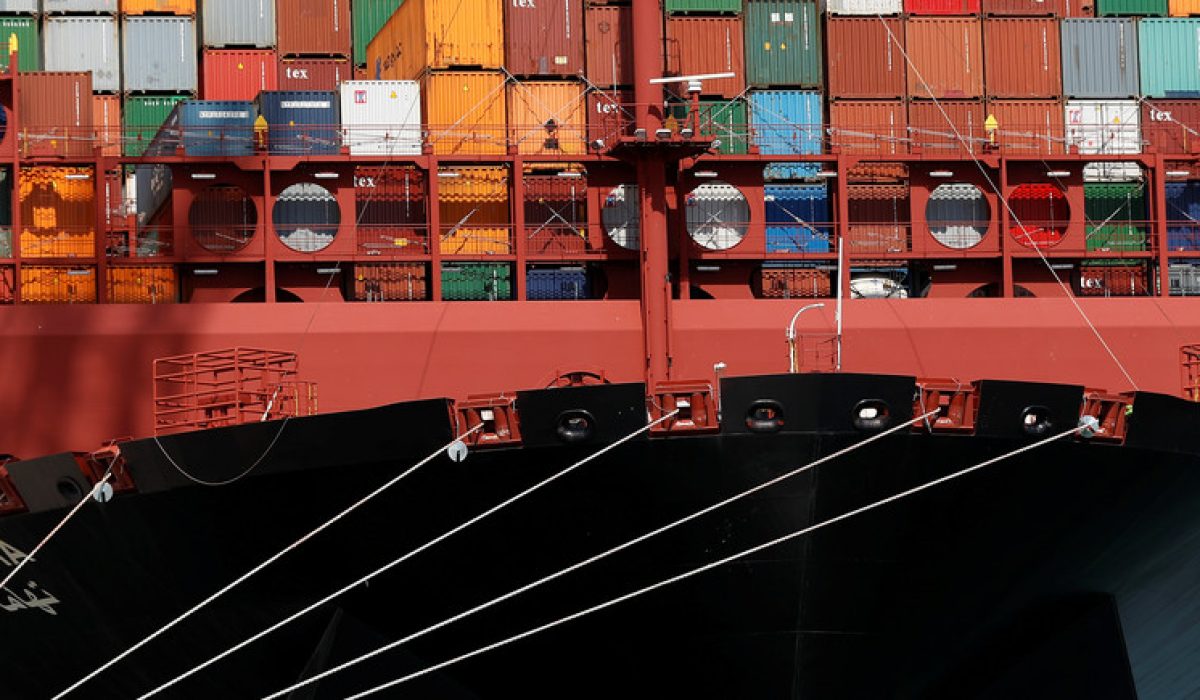This article is part of the World Economic Forum’s Geostrategy platform
Trade chokepoints – maritime, coastal and inland – pose an underexplored and growing risk to global food security, argues the report Chokepoints and Vulnerabilities in Global Food Trade.
Maritime chokepoints will become increasingly integral to meeting global food supply as population growth, shifting dietary preferences, bioenergy expansion and slowing improvements in crop yields drive up demand for imported grain.
Rising trade volumes, increasing dependence on imports among food-deficit countries, underinvestment, weak governance, climate change and emerging disruptive hazards together make chokepoint disruptions – both small-scale and large-scale – increasingly likely.
Climate change will have a compounding effect on chokepoint risk, increasing the probability of both isolated and multiple concurrent weather-induced disturbances.
Investment in infrastructure lags demand growth: critical networks in major crop-producing regions are weak and ageing, and extra capacity is urgently needed.
Three key crops
Global food security is underpinned by trade in a few crops and fertilizers. Just three crops – maize, wheat and rice – account for around 60% of global food energy intake. A fourth crop, soybean, is the world’s largest source of animal protein feed, accounting for 65% of global protein feed supply.
Each year, the world’s transport system moves enough maize, wheat, rice and soybean to feed approximately 2.8 billion people. Meanwhile, the 180 million tonnes of fertilizers applied to farmland annually play a vital role in helping us grow enough wheat, rice and maize to sustain our expanding populations. International trade in these commodities is growing, increasing pressure on a small number of ‘chokepoints’ – critical junctures on transport routes through which exceptional volumes of trade pass.
Three principal kinds of chokepoint are critical to global food security: maritime corridors such as straits and canals; coastal infrastructure in major crop-exporting regions; and inland transport infrastructure in major crop-exporting regions. A serious interruption at one or more of these chokepoints could conceivably lead to supply shortfalls and price spikes, with systemic consequences that could reach beyond food markets.
More commonplace disruptions may not in themselves trigger crises, but can add to delays, spoilage and transport costs, constraining market responsiveness and contributing to higher prices and increased volatility.
The chokepoints on which global food security depends
Chokepoints and Vulnerabilities in Global Food Trade offers a first-of-its-kind analysis of chokepoints in the global food system, combining trade data from the Chatham House Resource Trade Database with a purpose-built model to map bilateral commodity flows on to trade routes.
It identifies 14 chokepoints that are critical to global food security, indicated in Figure 1.
Among the maritime chokepoints, the Panama Canal and Strait of Malacca see the most significant grain throughput due to their positions linking Western and Asian markets.
Over one-quarter of global soybean exports transit the Strait of Malacca, primarily to meet animal feed demand in China and Southeast Asia. The Turkish Straits are particularly critical for wheat – a fifth of global exports pass through them each year, largely from the Black Sea ‘breadbasket’ region.

The most important inland and coastal chokepoints lie in the US, Brazil and the Black Sea, which account for 53% of global exports of wheat, rice, maize and soybean.
Inland waterways carry about 60% of US exports of the four crops (which account for 13% of worldwide exports) to the sea, primarily to the Gulf Coast ports. In Brazil, four ports on the south-eastern coastline are responsible for nearly a quarter of global soybean exports; these ports in turn depend on the roads linking them to the huge farms in the country’s interior.
Around 60% of Russian and Ukrainian wheat exports (12% of the global total, and growing fast), depend on rail to reach the Black Sea.
Chokepoint risk is increasing
These chokepoints are exposed to three broad categories of disruptive hazards.
First there are weather and climate hazards, including storms or floods that may temporarily close chokepoints, and weather-related wear and tear of infrastructure that reduces its efficiency and makes it more vulnerable to extreme events.
Second, security and conflict hazards may arise from war, political instability, piracy, organized crime and/or terrorism.
The third category of hazards are institutional, such as a decision by authorities to close a chokepoint or restrict the passage of food (for example, by imposing export controls). Minor disruptions are common. All but one of the chokepoints covered in this report has seen a closure or interruption of transit at least once in the past 15 years, and the risk of a crisis arising from such events should not be discounted. In June 2017, overland routes that carry 40% of Qatar’s food imports – including just under a fifth of its wheat imports – were closed as part of a blockade.
Such developments should be the catalyst for policymakers to prepare for worst-case scenarios, especially given the growing risks from extreme weather events.
Moreover, these risks are increasing, driven by three distinct trends.
Growing dependency
First, dependency on chokepoints is growing (see Figure 2). For example, in the past decade and a half the share of internationally traded grain and fertilizers passing through at least one of the maritime chokepoints has increased from 43% to 54%. A smaller but nonetheless significant share – 10% – now depends on transit through one or more of the maritime chokepoints as the only viable shipping route, up from 6% in 2000.

Growing international trade means that chokepoint dependency is likely to increase for the foreseeable future. Some chokepoints will come under more pressure than others. Rapid and continued growth in exports from the Black Sea region will increase dependence on the Turkish Straits, particularly for wheat. At the same time, sustained demand growth in China (averaging around 14% a year for soybean imports over the past 15 years) will continue to increase shipments from crop exporters in the West via the Panama Canal and the Strait of Malacca.
Climate change
Second, climate change is increasing the threat of disruption by acting as a hazard multiplier across all three categories of chokepoint risk. It will increase the frequency and severity of extreme weather, leading to more regular closures of chokepoints and greater wear and tear on infrastructure. Rising sea levels will threaten the integrity of port operations and coastal storage infrastructure, and will increase their vulnerability to storm surges.
Climate change is expected to aggravate drivers of conflict and instability. It will also lead to more frequent harvest failures, increasing the risk of governments imposing ad hoc export controls. Climate change may also increase the risk of concurrent supply disruptions.
As extreme weather events become more common, the chances of coincidental disruptions occurring at different locations are likely to increase. Examples might include distant chokepoints being simultaneously disrupted by different weather systems, or a major chokepoint in one part of the world being closed during a harvest failure in a crop-growing region elsewhere. In such circumstances, market impacts are compounded.
For example, if a hurricane comparable in ferocity to Hurricane Katrina in 2005 were to shut down US exports from the Gulf of Mexico at the same time as extreme rainfall rendered Brazil’s roads impassable (the latter happened in 2013), up to 50% of global soybean exports could be affected. If this in turn occurred in conjunction with a Black Sea heatwave similar to the one recorded in 2010, around 51% of global soybean shipments, together with 41% and 18% of global maize and wheat exports respectively, could be halted or delayed.
Have you read?
Urgent need for investment
Third, chronic underinvestment in infrastructure is creating a double deficit – of capacity with respect to growing trade volumes, and of resilience with respect to climate change.
The US’s inland waterways are old, congested, vulnerable to drought and flood, and likely to start failing in the near future; its Gulf Coast ports are vulnerable to hurricanes and storm surges. Brazil’s roads are poor and often rendered impassable by rain and subsidence. The Black Sea region requires significant investment in transport infrastructure, but regional instability is a deterrent to this.
Each of the above-mentioned regions must mobilize significant investment in the coming decades to prevent bottlenecks and climate vulnerability worsening, but all face challenges in doing so.
The outlook for increasing chokepoint risk must also be understood in the context of mounting pressures on agricultural markets. Growth in cereal yields has fallen behind projected growth in cereal demand.
Climate change is expected to exert a further drag on crop yields and become an increasingly destabilizing influence on global harvests. As a consequence, international markets are likely to become tighter and more volatile while dependence upon them increases.
Chokepoint failures threaten to compound market fragility by contributing to higher costs and longer delays in delivery, and by making major supply disruptions more likely.
Recommendations
- Integrate chokepoint analysis into mainstream risk management and security planning – for example, government agencies should assess exposure and vulnerability to chokepoint risk at the national and subnational levels.
- Invest in infrastructure to ensure future food security – for example by agreeing on guidelines for climate-compatible infrastructure through an international taskforce established under the G20.
- Enhance confidence and predictability in global trade – for example, through a process under the World Trade Organization (WTO) to continually reduce the scope for export restrictions.
- Develop emergency supply-sharing arrangements and smarter strategic storage, e.g. an emerging response mechanism among major players in the global food trade, modelled in part on that of the International Energy Agency in oil markets and led by the UN Food and Agriculture Organization (FAO), the UN World Food Programme (WFP) or the Agricultural Market Information System (AMIS).
- Build the evidence base around chokepoint risk – including through the collection of data on real-time food trade and infrastructural capacity to aid in assessing risks to food supply chains.



